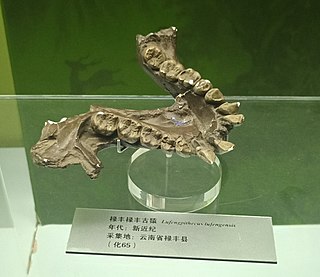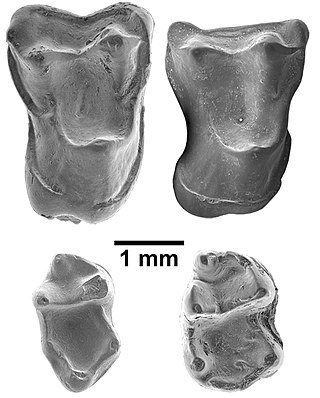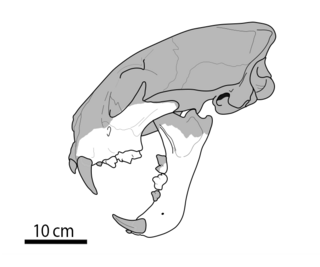
Homininae, is a subfamily of the family Hominidae (hominids). This subfamily includes two tribes, Hominini and Gorillini, both having extant species as well as extinct species.

Sivapithecus is a genus of extinct apes. Fossil remains of animals now assigned to this genus, dated from 12.2 million years old in the Miocene, have been found since the 19th century in the Sivalik Hills of the Indian subcontinent as well as in Kutch. Any one of the species in this genus may have been the ancestor to the modern orangutans.

Lufengpithecus is an extinct genus of ape, known from the Late Miocene of East Asia. It is known from thousands of dental remains and a few skulls and probably weighed about 50 kg (110 lb). It contains three species: L. lufengensis, L. hudienensis and L. keiyuanensis. Lufengpithecus lufengensis is from the Late Miocene found in China, named after the Lufeng site and dated around 6.2 Ma. Lufengpithecus is either thought to be the sister group to Ponginae, or the sister to the clade containing Ponginae and Homininae.
Stirtonia is an extinct genus of New World monkeys from the Middle Miocene. Its remains have been found at the Konzentrat-Lagerstätte of La Venta in the Honda Group of Colombia. Two species have been described, S. victoriae and the type species S. tatacoensis. Synonyms are Homunculus tatacoensis, described by Ruben Arthur Stirton in 1951 and Kondous laventicus by Setoguchi in 1985. The genus is classified in Alouattini as an ancestor to the modern howler monkeys.
Ekgmowechashala is an extinct genus of primate belonging to Adapiformes.
? Nycticebus linglom is a fossil strepsirrhine primate from the Miocene of Thailand. Known only from a single tooth, an upper third molar, it is thought to be related to the living slow lorises, but the material is not sufficient to assign the species to Nycticebus with certainty, and the species name therefore uses open nomenclature. With a width of 1.82 mm, this tooth is very small for a primate. It is triangular in shape, supported by a single root, and shows three main cusps, in addition to various crests. The absence of a fourth cusp, the hypocone, distinguishes it from various other prosimian primates.
Dermotherium is a genus of fossil mammals closely related to the living colugos, a small group of gliding mammals from Southeast Asia. Two species are recognized: D. major from the Late Eocene of Thailand, based on a single fragment of the lower jaw, and D. chimaera from the Late Oligocene of Thailand, known from three fragments of the lower jaw and two isolated upper molars. In addition, a single isolated upper molar from the Early Oligocene of Pakistan has been tentatively assigned to D. chimaera. All sites where fossils of Dermotherium have been found were probably forested environments and the fossil species were probably forest dwellers like living colugos, but whether they had the gliding adaptations of the living species is unknown.

Khoratpithecus is an extinct genus of pongin primates that lived during the late Miocene in Myanmar and Thailand.

Graecopithecus is an extinct genus of hominid that lived in southeast Europe during the late Miocene around 7.2 million years ago. Originally identified by a single lower jaw bone bearing teeth found in Pyrgos Vasilissis, Athens, Greece, in 1944, other teeth were discovered from Azmaka quarry in Bulgaria in 2012. With only little and badly preserved materials to reveal its nature, it is considered as "the most poorly known European Miocene hominoids." The creature was popularly nicknamed 'El Graeco' by scientists.

Afrasia djijidae is a fossil primate that lived in Myanmar approximately 37 million years ago, during the late middle Eocene. The only species in the genus Afrasia, it was a small primate, estimated to weigh around 100 grams (3.5 oz). Despite the significant geographic distance between them, Afrasia is thought to be closely related to Afrotarsius, an enigmatic fossil found in Libya and Egypt that dates to 38–39 million years ago. If this relationship is correct, it suggests that early simians dispersed from Asia to Africa during the middle Eocene and would add further support to the hypothesis that the first simians evolved in Asia, not Africa. Neither Afrasia nor Afrotarsius, which together form the family Afrotarsiidae, is considered ancestral to living simians, but they are part of a side branch or stem group known as eosimiiforms. Because they did not give rise to the stem simians that are known from the same deposits in Africa, early Asian simians are thought to have dispersed from Asia to Africa more than once prior to the late middle Eocene. Such dispersals from Asia to Africa also were seen around the same time in other mammalian groups, including hystricognathous rodents and anthracotheres.
Indraloris is a fossil primate from the Miocene of India and Pakistan in the family Sivaladapidae. Two species are now recognized: I. himalayensis from Haritalyangar, India and I. kamlialensis from the Pothohar Plateau, Pakistan. Other material from the Potwar Plateau may represent an additional, unnamed species. Body mass estimates range from about 2 kg (4.4 lb) for the smaller I. kamlialensis to over 4 kg (8.8 lb) for the larger I. himalayensis.

The evolutionary history of the primates can be traced back 57-90 million years. One of the oldest known primate-like mammal species, Plesiadapis, came from North America; another, Archicebus, came from China. Other similar basal primates were widespread in Eurasia and Africa during the tropical conditions of the Paleocene and Eocene. Purgatorius is the genus of the four extinct species believed to be the earliest example of a primate or a proto-primate, a primatomorph precursor to the Plesiadapiformes, dating to as old as 66 million years ago.
Nuciruptor is an extinct genus of New World monkeys from the Middle Miocene. Its remains have been found at the Konzentrat-Lagerstätte of La Venta in the Honda Group of Colombia. The type species is N. rubricae.
The Amphipithecidae were simian primates that lived in Late Eocene and Early Oligocene. Fossils have been found in Myanmar, Thailand, and Pakistan. The limited fossil evidence is consistent with, but not exclusive to, arboreal quadrupedalism. In other words, the species may have moved about in trees on four legs, but not with regular leaping as seen in later simians.

The Trachilos footprints are possibly tetrapod footprints which show hominin-like characteristics from the late Miocene on the western Crete, close to the village of Trachilos, west of Kissamos, in the Chania Prefecture. Researchers describe the tracks as representing at least one apparent bipedal hominin or an unknown primate. The stratum in which the footprints were found was dated to about 5.7 million years ago, which predates the previously earliest discovered hominin footprints by about two million years. Later studies show that the footprints might be more than 6 million years old. The researchers of the tracks suggest that it may imply the possibility of hominin evolution outside of Africa, contrary to the current theory. However, there is no consensus that these impressions are distinct enough to confidently assign to a primate or even a vertebrate, or that they are indeed footprints at all.
Patasola is an extinct genus of New World monkeys from the Middle Miocene. Its remains have been found at the Konzentrat-Lagerstätte of La Venta in the Honda Group of Colombia. The type species is Patasola magdalenae.
Varavudh Suteethorn, or Warawut Suteethorn is a Thai palaeontologist and geologist. He is the current director of the Palaeontological Research and Education Centre, Mahasarakham University. He is best known for his work on vertebrate paleontology in northeastern Thailand, having contributed to the discovery of many fossil taxa and dig sites in the Khorat Plateau, as a part of a long-standing collaboration between Thai and French scientists.
Kapi is an extinct primate genus that lived in northern India about 13.8 to 12.5 million years ago during the Miocene. The only species, K. ramnagarensis, was described in 2020 and is known from a complete lower molar. The fossil was discovered in 2015 from Ramnagar, a town in Jammu and Kashmir, for which the species name was created. Though originally identified as member of the gibbons and popularised in the news as the oldest gibbon, it was later reassessed as a pliopithecoid, a group of extinct Old World monkeys.
Ramadapis sahnii was a primitive primate belonging to Sivaladapidae that existed around 11 to 14 million years ago. Only a mandible was found at the dig site, which was near Ramnagar in Udhampur district in Jammu and Kashmir specifically the lower Siwalik deposits. The jawbone indicates that Ramadapis resembled a modern day ring-tailed lemur. The early lemur was named after Ashok Sahni, who discovered the first sivaladapid in the Siwalik deposits. The mandible was only around one and a quarter inch long, which led scientists to assume that it was only around 11 pounds.

Pachypanthera is an extinct genus of pantherine felid that was recovered from the Late Miocene-aged Khorat sand pits in northeastern Thailand. It contains a single species, Pachypanthera piriyai, named and described in 2023.










